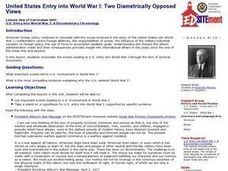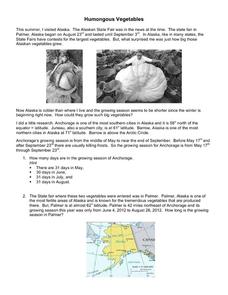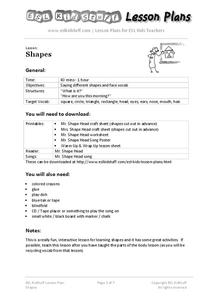EngageNY
Euler’s Number, e
Scholars model the height of water in a container with an exponential function and apply average rates of change to this function. The main attraction of the lesson plan is the discovery of Euler's number.
EngageNY
Solution Sets to Equations with Two Variables
Can an equation have an infinite number of solutions? Allow your class to discover the relationship between the input and output variables in a two-variable equation. Class members explore the concept through tables and graphs and...
EngageNY
Solution Sets to Inequalities with Two Variables
What better way to learn graphing inequalities than through discovering your own method! Class members use a discovery approach to finding solutions to inequalities by following steps that lead them through the process and...
EngageNY
Solution Sets to Simultaneous Equations (part 1)
How are systems related? Build on your pupils' previous knowledge of solving systems of equations by introducing systems of inequalities. Learners explore similarities between systems of equations and inequalities to make a strong...
EngageNY
Addition and Subtraction Formulas 2
Knowing the addition formulas allows for the calculations of double and half formulas. The fourth installment of 16 has the class use the addition formula to develop the double angle trigonometric formulas. Using the double formula,...
EngageNY
Addition and Subtraction Formulas 1
Show budding mathematicans how to find the sine of pi over 12. The third instructional activity in a series of 16 introduces the addition and subtraction formulas for trigonometric functions. Class members derive the formulas using...
EngageNY
Average Rate of Change
Learners consider the rate of filling a cone in the 23rd installment of this instructional activity series. They analyze the volume of the cone at various heights and discover the rate of filling is not constant. The instructional...
EngageNY
Writing and Graphing Inequalities in Real-World Problems
Inequalities: when one solution just doesn't suffice. Individuals learn to write inequalities in real-world contexts and graph solution sets on the number line. All inequalities in the lesson are of the form x < c or x < c.
Curated OER
Join the Peace Party
Encourage and recognize peace in classrooms, cities, states, and countries.
K5 Learning
The Bonfire in the Sea
Ever wonder why fish disappear from the surface of the water in cold weather? Fifth graders read a fun story about the magical fish tribe and their underwater bonfire before answering four comprehension questions.
Curated OER
Paragraph Structure
Make sure your writers have the buns and the meat in their paragraph burgers with paragraph exercises. The resource gradually leads up to individuals writing their own paragraphs, starting with identification exercises, moving on to...
Curated OER
United States Entry into World War I: Two Diametrically Opposed Views
Students analyze the events leading to U.S. entry into World War I. They read a speech by President Wilson and an opposition speech, list the reasons each gives for American entry into the war, and complete a Venn diagram.
Curated OER
Current Connections
Many of us read our history books and take each word as truth. Show learners that history can easily be altered depending on who writes it. Your class will watch a series of videos, read a first person testimony, and discuss the...
Curated OER
Island of the Blue Dolphins
In this reading worksheet, students answer 10 multiple-choice questions about the book. For example, "What caused the death of the old sea elephant?"
Curated OER
Analyze Complex Words
What is a complex word, and why is it so important we know what they are? Download this helpful PowerPoint to introduce root/base words, prefixes, and suffixes to your emerging readers. Clear, relevant examples are given, as well as a...
Curated OER
Subject and Predicate
Give your class foundational skills by teaching them how to identify the subject and the predicate of a sentence. Walk them through the information on the top of page one, and then let them complete the practice opportunity...
Curated OER
Fever 1793: Round Table Discussion
All things considered, it will be a good day for readers as they manage on their own to develop questions about what intrigues, bothers, or confuses them in Laurie Halse Anderson's tale of Mattie Cook and the Yellow Fever epidemic...
Curated OER
Scary Short Story Writing Lesson
There's nothing like the prospect of writing a scary story to get your middle schoolers' writing juices flowing! In the lesson presented here, pupils listen to scary short stories read to them by the teacher. Then, a discussion ensues...
Curated OER
Humongous Vegetables
Humongous vegetables can inspire and awaken your mathematicians to the large math concepts in our Common Core standards. What is the secret to growing such gargantuan garden objects in Alaska? In the state that is closest to the...
Exploratorium
Depth Spinner
Put a new twist on your collection of optical illusion activities. Affix the linked printable spiral to a drill, record player, or some other rotating tool. Have learners stare at the spinning disk for only 15 seconds and then look away....
NWT Literacy Council
How to Kit: Readers Theatre
Immerse your class in a good story with an extensive resource featuring reader's theater techniques. The worksheets are designed for both teacher and student, and carefully explain how to organize, write, and perform stories in a...
ESL Kid Stuff
Shapes
Work on shapes and body parts at the same time with a fun set of activities. Kids sing and read about Mr. Shape Head, who has shapes on his face, before making their own Mr. Shape Head.
Laboratory for Atmospheric and Space Physics
A Classroom Solar System
Create a scaled model of our solar system in your classroom! Scholars work collaboratively to build paper mache planets and hang them in their proper position to showcase each planet's location in the solar system.
NOAA
A Laboratory Simulation of Ocean Surface Currents
Stimulate interest in ocean currents with a simulation. The first installment of a five-part middle school series teaches future oceanographers about the forces that interact to cause ocean currents. A simulation shows how wind and...























